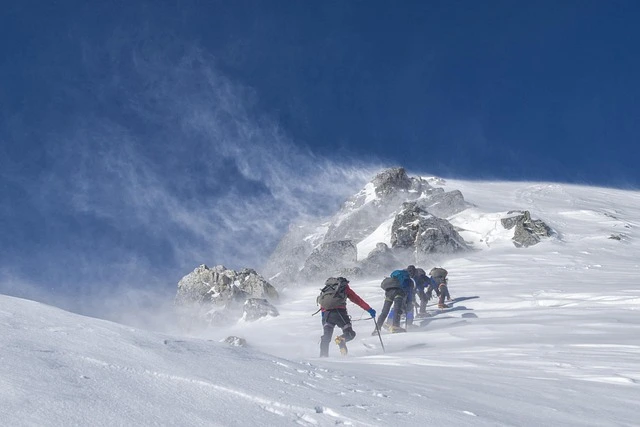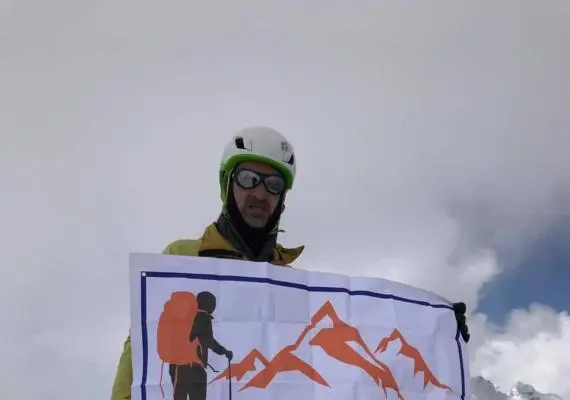Kyajo Ri Peak climbing offers adventurous mountaineers a thrilling technical challenge in the heart of the Khumbu region. Standing at 6,186 meters (though some sources cite 6,151m), this magnificent peak rises dramatically above the Gokyo Valley, presenting climbers with a perfect blend of technical difficulty and high-altitude adventure.|
Although classified as a trekking peak in Sagarmatha National Park, Kyajo Ri Peak climbing requires respect and proper mountaineering skills. Its remote location, mixed rock, snow, and ice terrain, and relatively recent climbing history make it an ideal choice for experienced trekkers seeking to progress into technical climbing without the crowds found on more popular peaks.
Trip Highlights
Your Kyajo Ri Peak climbing expedition delivers experiences that set it apart from other Himalayan climbs:
- Spectacular Summit Views: Witness a 360-degree panorama featuring Everest, Lhotse, Makalu, Cho Oyu, and the iconic Ama Dablam
- Technical Mixed Terrain: Navigate exciting combinations of rock, snow, and ice requiring fixed ropes and climbing expertise
- Remote, Less Crowded Experience: Enjoy solitude on a peak that sees far fewer attempts than neighboring mountains
- Sherpa Cultural Immersion: Trek through authentic villages, visit ancient monasteries, and experience genuine hospitality
- Wildlife Encounters: Spot Himalayan tahr, musk deer, and ghoral in their natural habitat
- Gokyo Valley Beauty: Explore turquoise glacial lakes and dramatic ice formations
- Crossing Renjo La Pass: Add a challenging 5,360m pass crossing to your adventure
- Sense of Achievement: Conquer a peak with genuine technical challenges and emotional payoff
Short 22-Day Itinerary
Days 1-2: Kathmandu Preparation Arrive for permit arrangements and gear checks. Meet your climbing Sherpa team.
Day 3: Fly to Lukla, Trek to Phakding The thrilling flight begins your Kyajo Ri Peak climbing adventure.
Days 4-5: Trek to Namche Bazaar Cross suspension bridges and climb to the Sherpa capital for acclimatization.
Days 6-8: Namche to Gokyo Valley Trek through rhododendron forests to the stunning Gokyo lakes region.
Day 9: Explore Gokyo Acclimatization day with optional Gokyo Ri hike for panoramic views.
Days 10-11: Cross Renjo La Pass to Thame Challenge yourself crossing 5,360m before descending to peaceful Thame valley.
Days 12-13: Trek to Kyajo Ri Base Camp Leave main trails behind entering true wilderness at 4,550m.
Days 14-15: Establish Camp I and Camp II Technical climbing begins with fixed ropes to 5,700m.
Day 16: Summit Day Alpine start for the final push to 6,186m summit.
Day 17: Reserve Day Weather contingency built into every Kyajo Ri Peak climbing itinerary.
Days 18-22: Return Trek Descend through familiar villages before flying back to Kathmandu.
Best Season for Kyajo Ri
Timing your expedition significantly impacts success rates.
Spring Season (March-May) offers stable weather patterns. March brings winter clarity with fewer crowds, though temperatures remain frigid. April represents the sweet spot with warming conditions and excellent visibility. May sees increasing afternoon clouds but provides good climbing windows. The best season for Kyajo Ri spring climbing coincides with rhododendron blooms at lower elevations.
Autumn Season (September-November) delivers crystal-clear mountain views. September can see lingering moisture, but conditions improve rapidly. October stands out as prime time with stable weather. November brings colder conditions but maintains visibility. This season sees more climbers overall but Kyajo Ri remains relatively quiet.
Monsoon and winter present significant challenges, making spring and autumn the clear choices for Kyajo Ri Peak climbing success.
Cost Breakdown
Understanding Kyajo Ri expedition package cost helps budget planning:
Overall Package Range: USD 2,800-5,000 A typical package costs approximately USD 3,185 including:
Permit Fees:
- Sagarmatha NP Entry: USD 30
- TIMS Card: USD 20
- Local Area Permit: USD 20
- Climbing Permit Spring: USD 300
- Climbing Permit Autumn: USD 150
Major Inclusions:
- Lukla Round-trip Flight: USD 370-400
- Expert Climbing Guide and Support Staff
- All Accommodation (teahouse + camping)
- Three Meals Daily During Trek
- Climbing Equipment and Fixed Ropes
Not Included:
- Personal Gear Rental: USD 200-300
- Travel Insurance: USD 150-300
- Tips for Staff: USD 200-300
- Personal Expenses: USD 200-300
Physical Fitness & Altitude Acclimatization
How technical is the Kyajo Ri climb? While classified as "moderate to semi-technical," successful Kyajo Ri Peak climbing demands solid fitness and basic mountaineering skills.
Physical Requirements:
- Excellent cardiovascular endurance
- Strong leg muscles for sustained climbing
- Good core strength for technical sections
- Previous high-altitude experience above 5,000m
- Mental resilience for challenging conditions
Technical Skills Needed:
- Basic crampon and ice axe usage
- Understanding rope work and fixed lines
- Experience with mixed terrain helpful
- Comfort with exposure on steep sections
Altitude Acclimatization Strategy follows proven principles with rest days at Namche (3,440m) and Gokyo (4,790m). Crossing Renjo La Pass provides excellent pre-climb acclimatization. The establishment of a progressive camp allows for a gradual adaptation essential for success on Kyajo Ri Peak climbing.
Packing List
Essential equipment for your expedition:
Technical Climbing Gear:
- Mountaineering boots (insulated, crampon-compatible)
- Crampons (12-point)
- Ice axe (60-70cm)
- Climbing harness
- Helmet (UIAA certified)
- Carabiners (4 locking, 4 non-locking)
Clothing Layers:
- Base layers (2 sets)
- Down jacket (rated to -20°C)
- Waterproof shell jacket and pants
- Insulated climbing gloves
- Warm hat and sun hat
- Gaiters for deep snow
Other Essentials:
- Sleeping bag rated to -20°C
- Headlamp plus spare
- Sunglasses (Category 4)
- Sun protection (SPF 50+)
- First-aid kit and altitude medication
- Water purification tablets
Cultural Highlights & Natural Beauty
Kyajo Ri Peak climbing immerses you in authentic Sherpa culture. Namche Bazaar bustles as the regional trading hub. Thame village, birthplace of Tenzing Norgay, preserves ancient customs. Traditional monasteries host colorful festivals throughout the climbing season.
The natural landscapes showcase Himalayan diversity. Rhododendron forests paint lower elevations while alpine meadows burst with seasonal wildflowers. The Gokyo lakes shine turquoise against barren moraines. Wildlife sightings include Himalayan tahr navigating impossible terrain, musk deer browsing forest clearings, and ghoral inhabiting steep grasslands.
These remote valleys preserve experiences in their purest form, far from tourist crowds that characterize other climbing routes.
Unique Angle / Emotional Appeal
What is Kyazo Ri (Kyajo Ri)? It's more than just another peak—it's a perfect balance of challenge and reward. The remote, less crowded experience defines its appeal. While Island Peak sees hundreds annually, Kyajo Ri might host a dozen expeditions per season.
The technical challenge with fixed ropes provides genuine mountaineering experience. Mixed rock, snow, and ice terrain demands real climbing skills beyond simple walking. The Kyajo Ri first ascent 2002 makes it a relatively "new" peak, adding to its mystique.
Comparison: Kyajo Ri vs Island Peak helps climbers choose appropriately. Island Peak offers straightforward snow climbing suitable for beginners. Kyajo Ri Peak climbing demands technical skills on mixed terrain. Both provide stunning summit views, but Kyajo Ri's position offers unique perspectives with far fewer crowds.
The emotional rewards extend beyond physical achievement. Standing atop a technical peak brings profound satisfaction. The journey through remote valleys creates lasting connections. Summit views encompassing Everest, Lhotse, Makalu, and Cho Oyu etch permanently in memory. The solitude amplifies every experience, creating a deeply personal achievement.
Conclusion
Kyajo Ri Peak climbing represents the perfect progression for trekkers ready to embrace technical mountaineering. This 6,186-meter giant offers genuine climbing challenges without extreme altitude risks. The combination of cultural trekking, wildlife encounters, and technical climbing creates an unforgettable Himalayan experience.
Success requires preparation, determination, and expert support. The remote nature and technical demands mean choosing the right partner becomes crucial for safe and successful Kyajo Ri Peak climbing.
HimalayanHero Adventure stands as a leading trekking company in Nepal, specializing in technical peak climbing expeditions. Our experienced climbing Sherpas have summited Kyajo Ri multiple times, ensuring safe expeditions. We provide top-tier services including quality equipment, experienced guides, and comprehensive support.
Our packages include all permits, domestic flights, accommodation, meals, and technical support. We maintain small group sizes for personalized attention. Our commitment to safety maximizes your summit chances while creating lasting memories.
Ready to challenge yourself on one of Nepal's most rewarding technical peaks? Let HimalayanHero Adventure guide you to the summit where achievement meets adventure.
Contact us today:
📧 Email: [email protected]
📱 WhatsApp: +9779801127073
🌐 Website: himalayanhero.com
Your summit awaits. The question isn't whether Kyajo Ri is calling—it's whether you're ready to answer.





